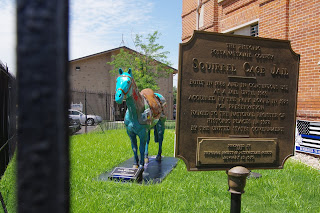July 20,
Squirrel Cage Jail, Council Bluffs, IA

One of the
strangest and oddball places we ever visited was the Pottawattamie County Jail
in Council Bluffs, IA, just over the state line from Omaha.
Built in
1885, the jail is listed on the National Register of Historic Places. The building is a Squirrel Cage Jail, also
known as a Rotary Jail.
At a cost of
$30,000, the building was one of 18 such jails that were built in the United
States and the only one that was three stories tall.
All the meals for the prisoners were prepared in this small kitchen.
The front
part of the jail contains a kitchen and a space that was used as an office for
the jailer.

The rest of the building is
made up of pie-shapped cells that revolved inside of a cage.
The building
was used as a jail until 1969.
The hole in the back of the cell was used as a toilet.

 The idea for
the rotary style jail was to produce a jail in which prisoners can be
controlled without the necessity of personal contact between them and the
jailer.
The idea for
the rotary style jail was to produce a jail in which prisoners can be
controlled without the necessity of personal contact between them and the
jailer. 
An entire jail full of prisoners
could all be controlled by just one jailer.
Instead of
going to the cells, the jailer could bring the cells and prisoners to him by
simply turning a crank.
Unfortunately,
the turntable gears kept jamming. The
drum weighted 45 tons empty, balanced on a three-foot-square base that kept
shifting in unstable soil.

The top of
the cage is suspended from a single iron beam.
Part of what
made the Squirrel Cage Jail so uniquely bad was its inability to segregate inmates. Chicken thieves and prostitutes were housed
with rapists and killers.
Broken legs
and arms were routine for prisoners who stuck their limbs through their cell
bars as the cage spun.
The jailer
and his family lived on the top floor apartment. The wife was employed as a cook preparing meals
two times a day for the prisoners.

The
meal trays were delivered through a slot.
Looking down from the private apartment of the jailer.
Solitary confinement was so narrow that there was only room to stand up.
In 1960 the
Fire Marshall permanently disabled the drum after it took two days to reach the
corpse of a prisoner who’d died in his cell.


















No comments:
Post a Comment